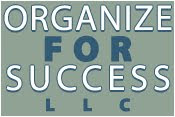Although many claim that one is a lonely number, I contend that one is a very powerful number for boosting your productivity. When you have one place to look for information, one place to update content and one place from which data feeds, it is easier to quickly find what you need when you need it, to update data as it changes and to verify information is processing correctly. Take action! Streamline your toolbox to have one tool for each of these:
●
Calendar - Each of us is only one human-being, whether at work, at home or somewhere in between; if you have one calendar for both personal and professional commitments, you are less likely to double-book yourself, more likely to remember where you need to be when and able to easily reference where you are spending all of your time. Choose whether a paper or electronic solution works better for your specific needs, and test out solutions to see which you prefer, like
Cozi,
EveryThink,
Google Calendar,
iCal,
Kalendi,
Outlook,
Sunrise or
Yahoo.
●
To-Do List - Since our brains are meant for thinking, not remembering, it is imperative to write down all that needs to get done. When tasks are jotted down on a Post-It note beside our computer screen, a napkin in the drive-through lane and the paper from our meeting notes, it becomes challenging to know what tasks need to be completed by when; however, when all tasks are culled together in one running data dump, it is easier to funnel what needs your attention into a daily to-do list, either paper or electronic. Tech tools like
Any.Do,
Asana,
Azendoo,
Carrot,
Clear,
Google Tasks,
Mavenlink,
Nozbe,
Pocket Informant,
Producteev,
Remember the Milk,
iOS' Reminders,
Todoist,
Toodledo,
Trello,
Wrike and
Wunderlist offer reminders, easier carryover, repeat options and integrations, whether working independently or in collaboration with your work teams, committees and family.
●
Address Book - If your contacts' information is synced between your computer and mobile devices, you have one database (or address book), which means you can more easily update any contact's information as it changes because we all know people move, change jobs and get new email addresses or phone numbers. Plus, if you have your contacts' information in such an electronic address book, it is easier to utilize tools like
EasilyDo,
Humin,
Sync.ME,
Brewster,
EverContact and
FullContact to double-check the accuracy of each connection's contact information.
●
Password Manager - Today's workflows often involve logging into many different platforms in addition to online banking, social media and bill-paying. Listing those usernames and passwords in one place can be a lifesaver, and an electronic solution is more secure, allows easier access while on-the-go, creates more secure passwords for you and can alert you automatically when any site has been hacked for more quickly resetting your password. Consider these low cost options:
Dashlane,
LastPass,
Roboform,
SplashID,
Sticky Password and
1Password.
●
Reference Tool - If you have one place for all the information you must reference and remember, it is much easier to find what you need when you need it. Personally, I prefer
Evernote to boost my workflows' effectiveness because it allows me to cull together all different types of information (typed text, handwritten notes, video, audio, web clippings, photos, documents), to add content via multiple methods (typing it in, photographing it, scanning it, emailing it in,
File This,
IFTTT), offers ubiquity of syncing all my information across my various different devices, allows me to annotate images, empowers great collaboration and provides superior search capabilities. No matter what option you choose, keep all your notes, checklists, research, process outlines, reading materials and more in one place for efficiency and easier access.
●
Cloud-Based, Automated Backup - Computers crash. Fires can destroy all your devices. Emergencies happen. Yet, you can be prepared with automated, remote storage. Unlike a hard-drive that you attach to your computer for backing up data, a cloud solution isn't at risk of natural disasters in your physical proximity, doesn't require you remembering to hook it up for activating the back-up and has multiple points at which your data storage is duplicated. See whether you can get the best deal for your specific needs via
Backblaze,
Carbonite,
CrashPlan or
Mozy.
●
File-Naming Structure - Whether your paper files, electronic documents or emails, having each folder and individual file follow the same naming conventions will allow you to know what goes where and more easily retrieve content later. If you have to ask "where should I file this?" when assigning a home to newly received or created content, how will you ever be able to find it later? Keep your file-naming structure simple so it is easy to replicate between platforms; then, make sure you have enough folders for all the content you will be storing while not having so many folders that any one item could go into more than one.
●
Weekly Strategy Session - Proactively create the direction in which you will proceed for the week ahead rather than starting in reactionary mode, focusing more on your priorities instead of being pulled to address others' priorities. You can take control of your productivity by being strategic and mapping out a specific game plan for addressing all that needs your attention.
Click here for a checklist and make time in your schedule to complete this Friday afternoon or over the weekend.
●
Daily Wrap-Up - To keep your weekly strategy on track amidst all the curveballs that life will throw your way, end each day with your daily wrap-up, where you address each of the work-life integration items covered in the
checklist linked here.
By streamlining your personal and professional tools for better organization, you will best make every minute matter.
What are some ways you can practice "the power of one" to boost your productivity via work-life integration? On which of these toolbox needs' will you take action today?































